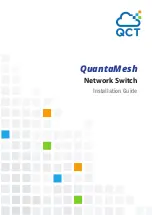
• The
f10BgpM2[Cfg]PeerReflectorClient
field is populated based on the assumption that route-reflector
clients are not in a full mesh if you enable
BGP client-2-client reflection
and that the BGP
speaker acting as reflector advertises routes learned from one client to another client. If disabled, it is
assumed that clients are in a full mesh and there is no need to advertise prefixes to the other clients.
• High CPU utilization may be observed during an SNMP walk of a large BGP Loc-RIB.
• To avoid SNMP timeouts with a large-scale configuration (large number of BGP neighbors and a large
BGP Loc-RIB), Dell Networking recommends setting the timeout and retry count values to a relatively
higher number. For example, t = 60 or r = 5.
• To return all values on an snmpwalk for the
f10BgpM2Peer sub-OID
, use the
-C c
option, such as
snmpwalk -v 2c -C c -c public<IP_address><OID>
.
• An SNMP walk may terminate pre-maturely if the index does not increment lexicographically. Dell
Networking recommends using options to ignore such errors.
• Multiple BPG process instances are not supported. Thus, the
f10BgpM2PeerInstance
field in various
tables is not used to locate a peer.
• Multiple instances of the same NLRI in the BGP RIB are not supported and are set to zero in the SNMP
query response.
• The
f10BgpM2NlriIndex
and
f10BgpM2AdjRibsOutIndex
fields are not used.
• Carrying MPLS labels in BGP is not supported. The
f10BgpM2NlriOpaqueType
and
f10BgpM2NlriOpaquePointer
fields are set to zero.
• 4-byte ASN is supported. The
f10BgpM2AsPath4byteEntry
table contains 4-byte ASN-related parameters
based on the configuration.
• If a received update route matches with a local prefix, then that route is discarded. This behavior results
from an incorrect BGP configuration. To overcome this issue, you can trigger a route refresh after you
properly configure BGP.
Traps (notifications) specified in the BGP4 MIB draft
<draft-ietf-idr-bgp4–mibv2–05.txt>
are not
supported. Such traps (
bgpM2Established
and
bgpM2BackwardTransition
) are supported as part of RFC 1657.
Configuration Information
The software supports BGPv4 as well as the following:
• deterministic multi-exit discriminator (MED) (default)
• a path with a missing MED is treated as worst path and assigned an MED value of (0xffffffff)
• the community format follows RFC 1998
• delayed configuration (the software at system boot reads the entire configuration file prior to sending
messages to start BGP peer sessions)
The following are not yet supported:
• auto-summarization (the default is no auto-summary)
• synchronization (the default is no synchronization)
Border Gateway Protocol IPv4 (BGPv4)
225
Summary of Contents for S4048T
Page 1: ...Dell Configuration Guide for the S4048T ON System 9 10 0 1 ...
Page 98: ... saveenv 7 Reload the system uBoot mode reset Management 98 ...
Page 113: ...Total CFM Pkts 10303 CCM Pkts 0 LBM Pkts 0 LTM Pkts 3 LBR Pkts 0 LTR Pkts 0 802 1ag 113 ...
Page 411: ...mode transit no disable Force10 Resilient Ring Protocol FRRP 411 ...
Page 590: ...Figure 67 Inspecting the LAG Configuration Link Aggregation Control Protocol LACP 590 ...
Page 646: ...Figure 87 Configuring Interfaces for MSDP Multicast Source Discovery Protocol MSDP 646 ...
Page 647: ...Figure 88 Configuring OSPF and BGP for MSDP Multicast Source Discovery Protocol MSDP 647 ...
Page 653: ...Figure 91 MSDP Default Peer Scenario 2 Multicast Source Discovery Protocol MSDP 653 ...
Page 654: ...Figure 92 MSDP Default Peer Scenario 3 Multicast Source Discovery Protocol MSDP 654 ...
Page 955: ...Figure 119 Single and Double Tag First byte TPID Match Service Provider Bridging 955 ...
















































